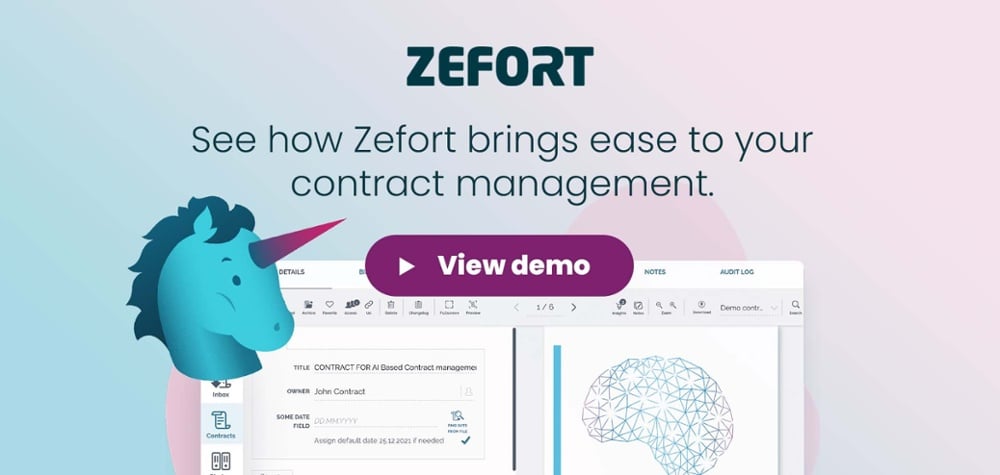Contracts are the lifeblood of any business, weaving together essential agreements and safeguarding valuable relationships. But let’s face it, the traditional way of handling contracts can sometimes feel like swimming upstream through a paperwork-laden river. From endless revisions to chasing down approvals, the contract process can be a time-consuming and error-prone ordeal.
That’s where contract lifecycle management (CLM) software steps in—a digital ally engineered to streamline your contractual processes.
In this article, we’ll dive deep into the world of CLM software, unraveling its benefits, functionalities, and practical tips to bring effortless efficiency to your contract management. So, wave goodbye to paper cuts, and get ready to ride the digital tide of smoother contract workflows.
What is contract lifecycle management (CLM) software
Contract lifecycle management software is a digital solution designed to effectively manage and streamline the entire contract lifecycle, from creation to expiration. It offers a centralized platform for businesses to store, organize, track, and analyze their contracts more efficiently. Here’s a concise explanation of what CLM software entails:
- Comprehensive contract management: CLM software enables businesses to handle all aspects of contract management with software solutions, including creating, negotiating, signing, storing, and analyzing contracts.
- Centralized contract repository: With CLM software, contracts are stored in a centralized cloud-based repository, accessible to authorized users from anywhere at any time. This eliminates the need for physical storage and minimizes the chances of misplacing or losing contracts.
- Automated contract workflows: CLM software automates contract approval workflows, enabling businesses to define approval hierarchies, set up notifications and reminders, and track the status of contract reviews and approvals in real-time.
- Contract analytics and reporting: CLM software offers robust reporting and analytics capabilities, providing insights into contract performance, obligations, key dates, and potential risks. This helps businesses make data-driven decisions and track contract compliance.
- Integration with other systems: CLM software can integrate with other critical business systems like CRM, ERP, and e-signature solutions, creating a seamless flow of information and reducing manual data entry.
- Enhanced compliance and risk management: By providing visibility into contract details and automating compliance checks, CLM software helps organizations mitigate risks, ensure regulatory compliance, and avoid penalties associated with non-compliance.
In summary, CLM software streamlines contract processes, enhances efficiency, improves accuracy, reduces risks, and empowers businesses to manage their contracts more effectively throughout their lifecycle.
Benefits of using CLM software
- Enhanced efficiency: CLM software streamlines contract processes, automating manual tasks such as generating, approving, and storing contracts. This saves time and resources, allowing organizations to handle more contracts in less time.
- Increased visibility: CLM software provides real-time visibility into the contract lifecycle, allowing teams to track contracts from initial creation to expiration and renewal. This visibility helps organizations stay organized, meet deadlines, and mitigate risks.
- Enhanced collaboration: CLM software facilitates collaboration among team members and stakeholders. It enables multiple users to work simultaneously on contracts, making it easier to communicate, review, and make revisions in real-time.
- Better compliance: Compliance with legal and regulatory requirements is crucial for businesses. CLM software helps maintain compliance by ensuring contracts follow established guidelines and protocols. It also provides audit trails and reporting functionalities for easier compliance monitoring.
- Cost savings: By reducing manual labor, minimizing errors, and optimizing contract processes, CLM software can generate significant cost savings in terms of time, resources, and operational inefficiencies.
- Risk mitigation: CLM software helps organizations identify and mitigate risks by providing contract oversight and ensuring compliance with contractual obligations. It also alerts users to upcoming contract expirations, preventing missed renewal opportunities.
- Improved customer relationships: Streamlined contract processes enable faster turnaround times and more transparent communication. This positively impacts customer relationships by reducing delays, providing better service, and fostering trust and satisfaction.
Steps to streamline contract processes with CLM software
Identify and prioritize contract types
Identifying and prioritizing contract types is an essential step in streamlining your contract processes with CLM software. It involves categorizing the various types of contracts your business deals with and determining their significance and frequency.
By clearly identifying and categorizing different contract types, you can effectively prioritize them based on their importance and impact on your organization. This allows you to allocate appropriate resources, assign responsible parties, and set predefined workflows for each contract type within your CLM software.
For instance, you may have different contract types such as sales contracts, vendor agreements, service level agreements, or non-disclosure agreements. Each contract type may have its own unique requirements, approval processes, and deadlines. By recognizing and prioritizing these different types, you can ensure that the relevant stakeholders are involved at the appropriate stages and that the necessary steps are followed for each contract type.
Create a centralized repository of contracts
A good contract management solution provides a single, centralized archive or repository for all contracts.
By having a centralized repository, you eliminate the need to search through various folders, emails, or physical files to locate the right contract. This saves time and effort and ensures that everyone is working with the most up-to-date versions.
Organizing contracts in a centralized repository also allows for better version control. Multiple versions of a contract can be confusing and lead to errors. With a central repository, you can clearly identify and manage different versions, ensuring that the correct version is used for each contract.
Furthermore, a centralized repository simplifies collaboration and collaboration among team members. Contract managers can easily share templates with stakeholders, enabling more efficient review and approval processes. This eliminates the need for manual back-and-forth exchanges and enables real-time collaboration, enhancing communication and productivity.
Automate contract approvals and workflows
By utilizing CLM software, you can streamline and automate the process of obtaining approvals for different stages of contract development. The software helps define approval workflows, allowing contracts to be routed to the relevant stakeholders in a systematic manner. Automated notifications and reminders ensure timely responses and reduce delays in the approval process. This eliminates the need for manual communication and tracking, reducing errors and improving overall efficiency.
Monitor contract expiration dates and renewals
Monitoring contract expiration dates and renewals is a critical aspect of streamlined contract management. This ensures that contracts are not inadvertently allowed to expire, which can lead to significant risks and missed opportunities. Here is a detailed explanation of how to effectively monitor contract expiration dates and renewals:
- Set reminders and alerts: Utilize the CLM software’s notification feature to set up reminders for contract expiration dates and upcoming renewals. These reminders can be sent to designated individuals or teams responsible for contract management.
- Automated notifications: CLM software can automate the process of sending notifications and reminders to all relevant stakeholders as contracts approach their expiration dates. This eliminates the need for manual tracking and ensures timely action.
- Contract tracking dashboard: Take advantage of the CLM software’s dashboard feature to have a centralized view of all active contracts, their expiration dates, and upcoming renewals. This provides a comprehensive overview and helps prioritize contracts that require attention.
- Proactive contract management: Regularly review the status of contracts nearing expiration using the CLM software’s reporting and analytics capabilities. This allows for proactive decision-making and avoids last-minute contract renewals.
- Contract repository organization: Ensure that all contracts are properly archived and organized within the CLM software. This facilitates easy retrieval and quick access to contract details, including expiration dates and renewal terms.
- Historical data analysis: Leverage the data and analytics provided by the CLM software to analyze previous contract renewals.
This can help identify trends, negotiation patterns, and potential areas for improvement in the renewal process.
By effectively monitoring contract expiration dates and renewals with the help of CLM software, businesses can ensure that contracts are renewed in a timely manner, minimize the risk of unnecessary contract lapses, and optimize their contract management processes.
Choosing the right CLM software for your business
Consider your organization’s needs
Before selecting a CLM software, it is crucial to evaluate your organization’s specific requirements. This entails understanding the volume and complexity of your contracts, as well as the necessary features and functionality needed to streamline your contract processes. By considering your organization’s unique needs, you can choose a CLM software that aligns with your goals and maximizes efficiency.
Compare features and pricing
When comparing features and pricing of contract lifecycle management software, it is important to thoroughly assess what each software offers and how it aligns with your organization’s needs.
Start by making a list of the features that are crucial for your contract management processes. This could include centralized contract storage, automated workflows, reporting and analytics, contract templates, integration options, and customization capabilities.
Next, gather pricing information from different CLM software providers. Take into consideration the different pricing models such as subscription-based, per user, or one-time payment options.
When comparing features, look for software that offers a comprehensive set of tools to cover all aspects of your contract processes. It should have an intuitive user interface, customizable dashboards, and advanced search capabilities to make it easy to find and manage contracts.
Consider the level of automation provided by the software. Does it offer automatic alerts and notifications for contract renewals and expirations? Can it streamline approval processes and enable collaborative contract negotiation?
Evaluate the scalability and flexibility of the software. Will it be able to accommodate your organization’s growth and changing contract management needs? Can it integrate with other systems you already use, such as customer relationship management (CRM) or enterprise resource planning (ERP) software?
It’s also essential to read reviews and seek references from other users or colleagues who have implemented similar CLM software. Their insights and experiences can provide valuable information about the software’s reliability, support, and overall user satisfaction.
By comparing features and pricing in detail, you can make an informed decision and choose the CLM software that best fits your organization’s requirements, streamlining your contract processes and improving overall efficiency.
Read reviews and seek references
Reading reviews and seeking references is an important step when choosing the right CLM software for your business. Reviews provide insights from customers who have already used the software, giving you an idea of its strengths and weaknesses.
Seek references by reaching out to other businesses or professionals who have implemented CLM software. By speaking directly to these references, you can gain valuable firsthand information about their satisfaction with the software and how it has streamlined their contract processes.
References can provide honest feedback and recommendations based on their personal experiences. Remember to consider the credibility and relevance of both reviews and references in order to make an informed decision.
Conclusion
In conclusion, implementing contract lifecycle management software can significantly streamline your contract processes and improve efficiency. Here are the key points to consider:
- Successful implementation of CLM software can lead to time and cost savings by automating manual tasks and reducing administrative errors.
- CLM software helps create a centralized repository of contract templates, making it easier to access, edit, and manage contracts.
- By utilizing contract authoring tools, you can streamline the contract creation process, ensuring consistency and accuracy.
- Automated contract approvals and workflows enable faster contract reviews and reduce bottlenecks.
- With CLM software, tracking contract expiration dates and renewals becomes effortless, ensuring timely action and avoiding unnecessary penalties or missed opportunities.
- When selecting CLM software, consider important features such as contract authoring capabilities, robust reporting and analytics, integration with other systems, and customization options.
- Assess your organization’s specific needs and compare different CLM software options to find the one that best fits your requirements.
- Research user reviews and seek references to ensure the chosen CLM software has a proven track record of success.
- By streamlining contract processes with CLM software, your organization can improve contract management efficiency, mitigate risks, and enhance overall business performance.






